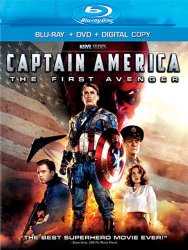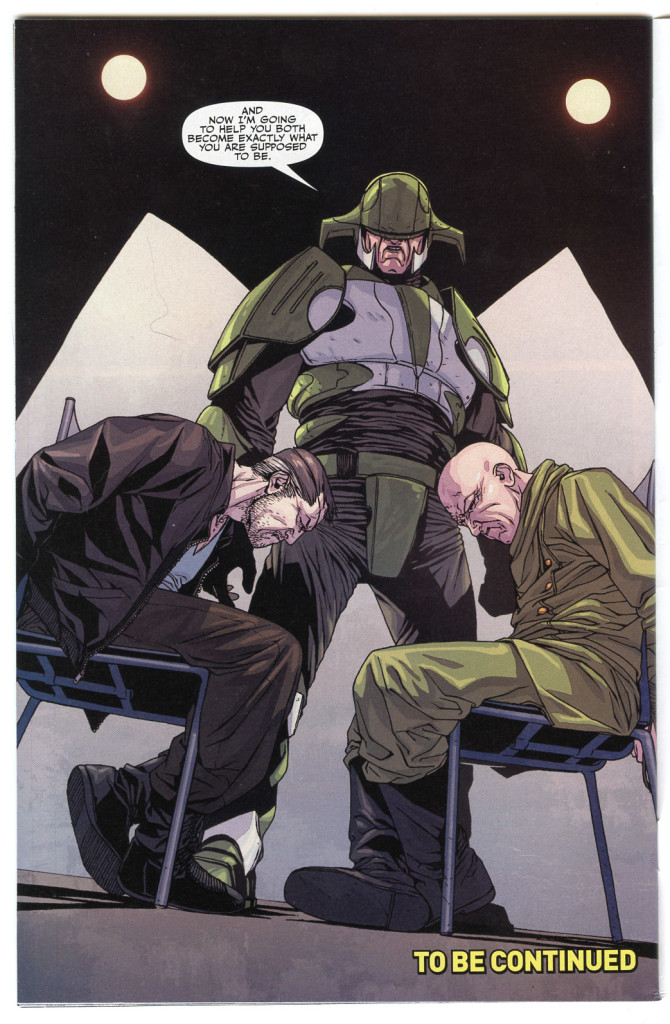For a regular review, once again, you may go to Rotten Tomatoes. This is a review from a student of comics, mostly, 1961- 1977 who will not discuss spoilers, but will try to place this within the frame of the current Marvel Movie Universe.
This movie, of course fits right into the Marvel Universe. But, unlike Guardians of the Galaxy, it expands and helps define the movie version of it. It also changes things on the TV show, Agents of S.H.I.E.L.D., and makes it better.
The Blu-ray images and sound look very good, a 4.7 out of a 5 rating.

Captain America: The First Avenger (Two-Disc Blu-ray/DVD Combo + Digital Copy)
Virtually all the Marvel movies, (made now by three separate companies), have used the material from the 1960s and early 1970s comics. Daredevil, X-Men, and Wolverine have wandered into the early 1980s. We had not seen anything from the last 30 years. Until now.
Created just before WW II, Captain America is an anachronism, a relic of a previous time. His costume was the American flag, something the country needed when he was created by Joe Simon and Jack Kirby .But Cap’s great appeal began to ebb after the war, as did the appeal of many super-heroes and most were gone by 1950. Cap had a short revival in the mid 1950s.
In the late 1950s DC comics began to revive their superhero line by taking old concepts and giving them a totally clean slate, with new characters having the old powers, totally forgetting their past continuity. When the publisher of Marvel comics, never an innovator, Martin Goodman saw that superheroes were successful again he started putting out new super-hero comics.
When Marvel’s editor and writer Stan Lee began to introduce new characters he was careful not to repeat the mistakes of the past. The old comics had not sold, so he, and his co-writers and artists Jack Kirby, Steve Ditko and Don Heck innovated change. There were no more sidekicks. Stan wanted teenage readers to identify with the actual hero, not their partner, so he created teenage heroes including Spiderman and the X-Men.
When they reintroduced Cap in Avengers #4 (1964) Lee and Kirby had a choice to make. They could have made him a totally new modern character, as they did with Johnny’s Storm’s Human Torch. This would have created a conundrum. The country was being torn apart over the Vietnam War, so how can you make a character so patriotic, so wrapped in the flag, relevant? (In comics relevant means “able to sell comics. “) So, by freezing “the original” Cap in the 1940s and reviving him in the 1960s, they made character himself an anachronism. He became someone who felt out of his own time, someone looking for his own place, someone haunted by his past. And there was no Bucky: he had died at the hands of Baron Zemo, a Nazi under orders from the Red Skull!
While writer Stan seemed to feel strongly about this, apparently Jack Kirby didn’t. Kirby was the co-writer/plotter and artist on the series. To Kirby, Cap was the same hero he had always been, there was no self doubt. In fact, Kirby didn’t want to kill Bucky. It is only after Kirby leaves, Lee partners with Gene Colan to put Cap on a motorcycle and have him take off across America on journey of self-discovery.
When this movie opens, you can see a great deal of doubt from Steve Rogers. This is the 1960s Cap who once said “Perhaps I should have battled less and questioned more.”
I was surprised how much I enjoyed the movie, it was real sit-back, eat-the-popcorn, and enjoy-the-movie sort of thing. One where you hope you don’t have to go to the bathroom and miss something. The first thing that struck me about this movie is that it was very adult. Yes, this is a superhero action movie which that it exist in a different universe, where the rules of physics, medicine and rules of common sense are often forgotten (or avoided). But they mixed in a spy thriller plot line, with espionage, counterspies, and Robert Redford, who added class to the whole thing. And look for a cameo from Gary Shandling. There is also a voiceover by Gary Sinese.
Nick Fury, originally Sgt. Fury, a veteran of WWII, was established as a super-secret agent and head of S.H.I.E.L.D. His first villains were a typical group of bad guys, named Hydra, a criminal organization that was run corporate bookkeeper. It was writer/artist Jim Steranko who elevated Hydra to the super-villain category, giving them a Nazi past.
Ed Brubaker, the current writer of Captain America, said that he did not like any of the stories or the character development after 1980. He was right: it was awful. So, a few years ago, he eliminated 30 years of continuity and picked up the story lines from 1980. Brubaker brought back a brainwashed Bucky and called him the Winter Soldier. This would be the first modern plot put into a Marvel movie. In my era, death was usually fatal. This added suspense and intrigue to the stories. In today’s comics, death is curable.
So I wonder how this would fit it. And it fit in very nicely, much better than I ever would’ve suspected. It didn’t work well for me in comic books. Captain America has had 70 years of continuity and you cannot just throw out 30 years and have it make sense. However, this is just the third movie with Captain America and only the second one to deal with his personal profile. So Bucky’s coming back, as a Hydra agent, “the Winter Soldier” after just three years of the movies pretty much worked. This movie is only 50% that storyline. With the Iron Curtain long gone, Hydra has been established as Marvel’s plotting and evil Cold War nemesis. It totally borrows from the issues of Secret Warriors involving the Marvel Universe in a Spy vs. Spy situation, S.H.I.E.L.D. vs. Hydra. And the head of Hydra, the Nazi Baron Strucker, appears. He also survived these last 70 years and looks great!!!!
ILM (Industrial Light and Magic) did the special effects. Both they and Marvel are now owned by Disney. Most scenes looked great and grand, except some of the Falcon’s flying sequences looked awkward.
For fans of the Marvel MOVIE Universe, who know nothing of the comics but enjoy the movies, there are a lot of reoccurring characters including the Black Widow (Scarlett Johansson), Nick Fury (Samuel L. Jackson), Arnim Zola (Toby Jones), Maria Hill (Cobie Smulders), Peggy Carter (Hayley Atwell). One thing that helps hold this Universe together is the consistency of the casting. With the exception of “Rhodey” in Iron Man and the three Hulks we have had, even the small parts keep the original actors. Of course Stan Lee makes a cameo and he has been in more Marvel movies than anyone. Comic book fans would recognize the references to Dr. Strange, Jasper Sitwell, and the introduction of the Scarlett Witch and Quicksilver.
Sadly, I found the disc “extras” a waste of time. They break down the “behind the scenes” stuff into three segments, one ten-minute one and two others less than three minutes. Here, they just show you how they did the stunts. The blooper reel is also just about three minutes and its fun, but short.
It was easy to bring back the Torch and the SUB-MARINER. I had to find a good way to bring back Captain America. I couldn’t think of a way to do it. (with) THE AVENGERS I had a bunch of other characters for him to play against and react to and. . .Captain America really needs other people to, to talk to and to be contrasted with ‘cause by himself he, he doesn’t have quite as colorful a personality as some of our other characters. wasn’t as sure of Captain America. Captain America we had. . .Over the years, you know, he was probably the first, one of the first characters MARVEL ever did and after the war he lost popularity and they dropped the book. Then they brought him back a few years later, dropped the book I wanted to wait until I could get just the right story. It was even difficult to bring back a patriotic character because the, the country wasn’t in the mood for that kind of patriotism at the time we brought back Captain America. They, they weren’t interested in the Army. Nobody wanted us to be at war, certainly, and there was a lot of disenchantment with the government and with the establishment, and Captain America was so much an establishment character.
Well, what I did. . .was give him a problem. He felt he was out of sync with the time he lived in. He felt he was an anachronism. He realized that he was thinking like somebody in the late ’30s and early ’40s, but here he was living in the ‘60s, and he felt he’d never quite be on the same wavelength as the people. . .You know he had been, frozen in a glacier for about 20 years or something and consequently he would agonize about the fact that he didn’t feel he fit in. I remember, I think there was one line I wrote that I liked very much where he said “Maybe he should have battled less and questioned more,” and I think that was the philosophy we tried to give him but he couldn’t really change his nature.
—Stan Lee, 2000 interview
